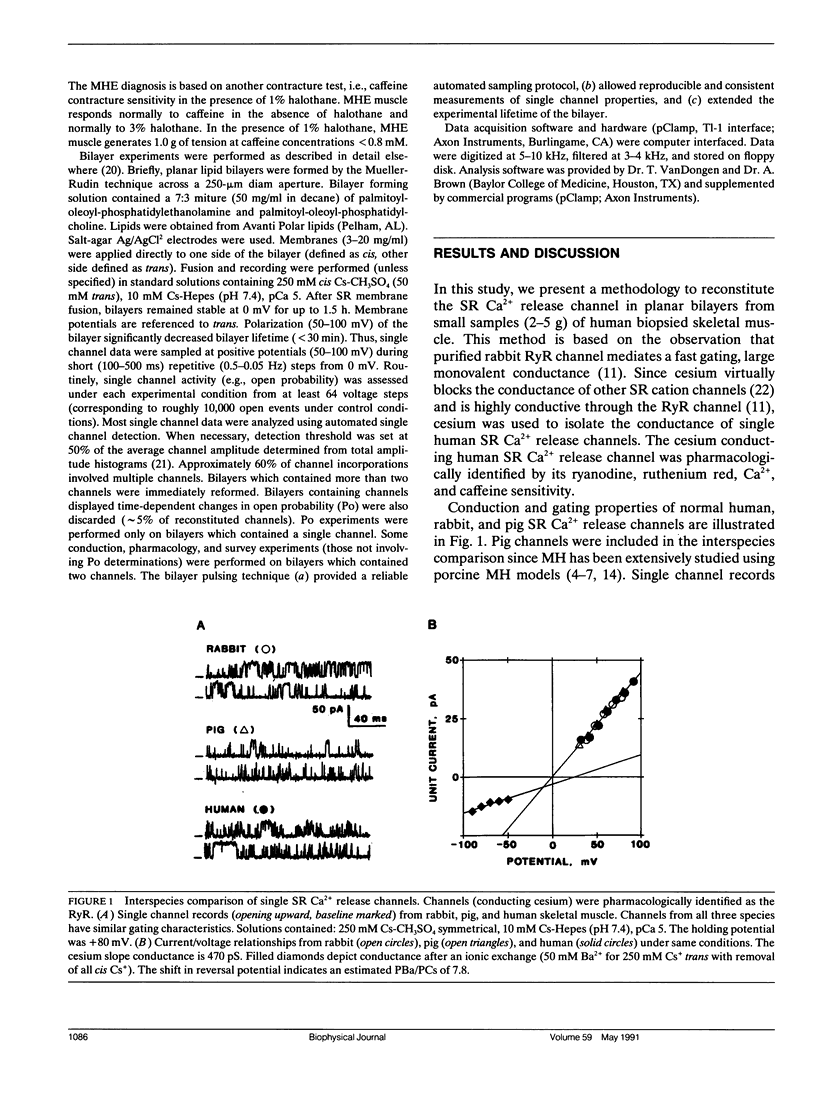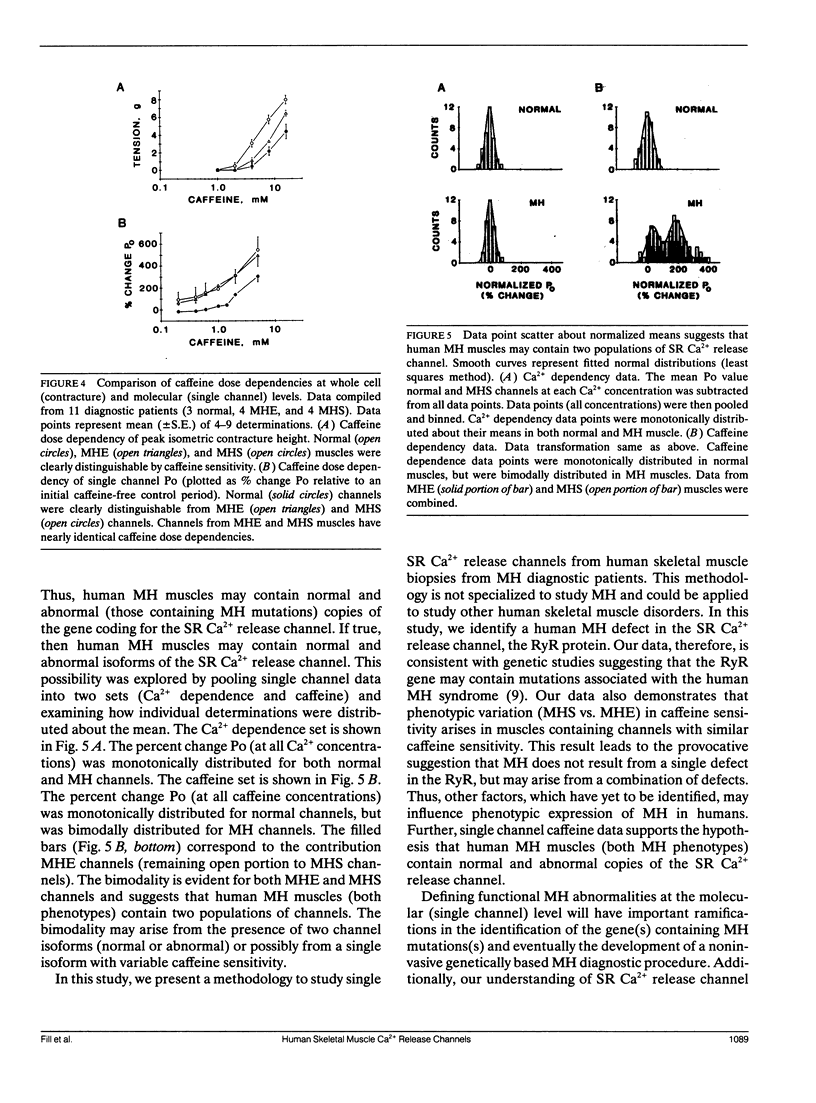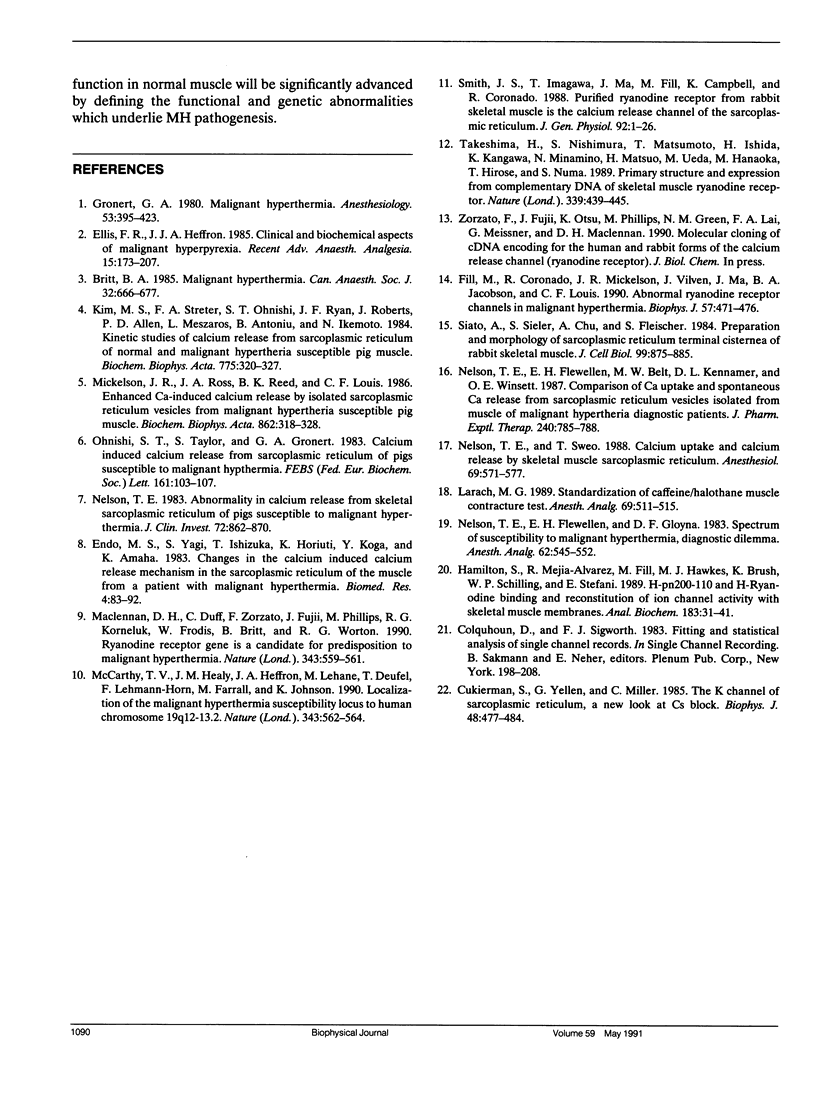Abstract
Single sarcoplasmic reticulum (SR) Ca2+ release channels were reconstituted from normal and malignant hyperthermic (MH) human skeletal muscle biopsies (2-5 g samples). Conduction, gating properties, and myoplasmic Ca2+ dependence of human SR Ca2+ release channels were similar to those in other species (rabbit, pig). The MH diagnostic procedure distinguishes three phenotypes (normal, MH-equivocal, and MH-susceptible) on the basis of muscle contracture sensitivity to caffeine and/or halothane. Single channel studies reveal that human MH muscles (both MH phenotypes) contain SR Ca2+ release channels with abnormally greater caffeine sensitivity. Muscles from MH-equivocal and MH-susceptible patients appear to contain channels with the same abnormality. Further, our data (n = 115, 21 channels, 11 patients) reveals that human MH muscles (both phenotypes) may contain two populations of SR Ca2+ release channels, possibly corresponding to normal and abnormal isoforms. Thus, whole cell phenotypic variation (MH-equivocal vs. MH-susceptible) arises in muscles containing channels with similar caffeine sensitivity suggesting that human MH does not arise from a single defect. These results have important ramifications concerning (a) correlation of functional and genetic MH studies, (b) identification of other, yet to be determined, factors which may influence MH expression, and (c) characterization of normal SR Ca2+ release channel function by exploring genetic channel defects.
Full text
PDF





Selected References
These references are in PubMed. This may not be the complete list of references from this article.
- Britt B. A. Malignant hyperthermia. Can Anaesth Soc J. 1985 Nov;32(6):666–678. doi: 10.1007/BF03011418. [DOI] [PubMed] [Google Scholar]
- Cukierman S., Yellen G., Miller C. The K+ channel of sarcoplasmic reticulum. A new look at Cs+ block. Biophys J. 1985 Sep;48(3):477–484. doi: 10.1016/S0006-3495(85)83803-0. [DOI] [PMC free article] [PubMed] [Google Scholar]
- Fill M., Coronado R., Mickelson J. R., Vilven J., Ma J. J., Jacobson B. A., Louis C. F. Abnormal ryanodine receptor channels in malignant hyperthermia. Biophys J. 1990 Mar;57(3):471–475. doi: 10.1016/S0006-3495(90)82563-7. [DOI] [PMC free article] [PubMed] [Google Scholar]
- Gronert G. A. Malignant hyperthermia. Anesthesiology. 1980 Nov;53(5):395–423. doi: 10.1097/00000542-198011000-00007. [DOI] [PubMed] [Google Scholar]
- Hamilton S. L., Alvarez R. M., Fill M., Hawkes M. J., Brush K. L., Schilling W. P., Stefani E. [3H]PN200-110 and [3H]ryanodine binding and reconstitution of ion channel activity with skeletal muscle membranes. Anal Biochem. 1989 Nov 15;183(1):31–41. doi: 10.1016/0003-2697(89)90167-x. [DOI] [PubMed] [Google Scholar]
- Kim D. H., Sreter F. A., Ohnishi S. T., Ryan J. F., Roberts J., Allen P. D., Meszaros L. G., Antoniu B., Ikemoto N. Kinetic studies of Ca2+ release from sarcoplasmic reticulum of normal and malignant hyperthermia susceptible pig muscles. Biochim Biophys Acta. 1984 Sep 5;775(3):320–327. doi: 10.1016/0005-2736(84)90187-1. [DOI] [PubMed] [Google Scholar]
- Larach M. G. Standardization of the caffeine halothane muscle contracture test. North American Malignant Hyperthermia Group. Anesth Analg. 1989 Oct;69(4):511–515. [PubMed] [Google Scholar]
- MacLennan D. H., Duff C., Zorzato F., Fujii J., Phillips M., Korneluk R. G., Frodis W., Britt B. A., Worton R. G. Ryanodine receptor gene is a candidate for predisposition to malignant hyperthermia. Nature. 1990 Feb 8;343(6258):559–561. doi: 10.1038/343559a0. [DOI] [PubMed] [Google Scholar]
- McCarthy T. V., Healy J. M., Heffron J. J., Lehane M., Deufel T., Lehmann-Horn F., Farrall M., Johnson K. Localization of the malignant hyperthermia susceptibility locus to human chromosome 19q12-13.2. Nature. 1990 Feb 8;343(6258):562–564. doi: 10.1038/343562a0. [DOI] [PubMed] [Google Scholar]
- Mickelson J. R., Ross J. A., Reed B. K., Louis C. F. Enhanced Ca2+-induced calcium release by isolated sarcoplasmic reticulum vesicles from malignant hyperthermia susceptible pig muscle. Biochim Biophys Acta. 1986 Nov 17;862(2):318–328. doi: 10.1016/0005-2736(86)90234-8. [DOI] [PubMed] [Google Scholar]
- Nelson T. E. Abnormality in calcium release from skeletal sarcoplasmic reticulum of pigs susceptible to malignant hyperthermia. J Clin Invest. 1983 Sep;72(3):862–870. doi: 10.1172/JCI111057. [DOI] [PMC free article] [PubMed] [Google Scholar]
- Nelson T. E., Flewellen E. H., Belt M. W., Kennamer D. L., Winsett O. E. Comparison of Ca++ uptake and spontaneous Ca++ release from sarcoplasmic reticulum vesicles isolated from muscle of malignant hyperthermia diagnostic patients. J Pharmacol Exp Ther. 1987 Mar;240(3):785–788. [PubMed] [Google Scholar]
- Nelson T. E., Flewellen E. H., Gloyna D. F. Spectrum of susceptibility to malignant hyperthermia--diagnostic dilemma. Anesth Analg. 1983 Jun;62(6):545–552. [PubMed] [Google Scholar]
- Nelson T. E., Sweo T. Ca2+ uptake and Ca2+ release by skeletal muscle sarcoplasmic reticulum: differing sensitivity to inhalational anesthetics. Anesthesiology. 1988 Oct;69(4):571–577. doi: 10.1097/00000542-198810000-00018. [DOI] [PubMed] [Google Scholar]
- Ohnishi S. T., Taylor S., Gronert G. A. Calcium-induced Ca2+ release from sarcoplasmic reticulum of pigs susceptible to malignant hyperthermia. The effects of halothane and dantrolene. FEBS Lett. 1983 Sep 5;161(1):103–107. doi: 10.1016/0014-5793(83)80739-x. [DOI] [PubMed] [Google Scholar]
- Saito A., Seiler S., Chu A., Fleischer S. Preparation and morphology of sarcoplasmic reticulum terminal cisternae from rabbit skeletal muscle. J Cell Biol. 1984 Sep;99(3):875–885. doi: 10.1083/jcb.99.3.875. [DOI] [PMC free article] [PubMed] [Google Scholar]
- Smith J. S., Imagawa T., Ma J., Fill M., Campbell K. P., Coronado R. Purified ryanodine receptor from rabbit skeletal muscle is the calcium-release channel of sarcoplasmic reticulum. J Gen Physiol. 1988 Jul;92(1):1–26. doi: 10.1085/jgp.92.1.1. [DOI] [PMC free article] [PubMed] [Google Scholar]
- Takeshima H., Nishimura S., Matsumoto T., Ishida H., Kangawa K., Minamino N., Matsuo H., Ueda M., Hanaoka M., Hirose T. Primary structure and expression from complementary DNA of skeletal muscle ryanodine receptor. Nature. 1989 Jun 8;339(6224):439–445. doi: 10.1038/339439a0. [DOI] [PubMed] [Google Scholar]


